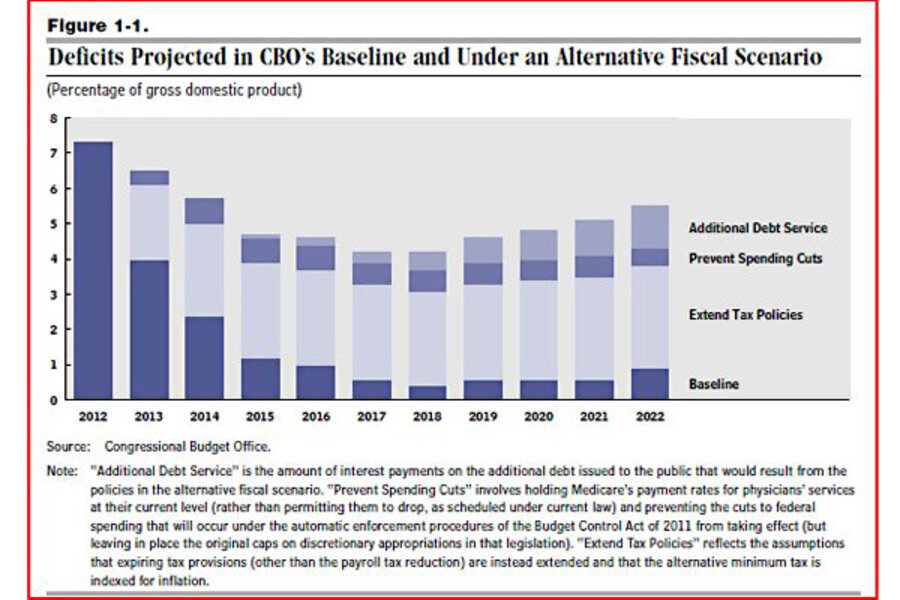CBO releases new budget outlook. What does it tell us?
Loading...
The Congressional Budget Office released their latest budget and economic outlook yesterday, and although the basic messages are not really new, they do show some new ways of presenting their numbers that help reinforce those basic messages.
First, Figure 1-1 above, from page 3 of the report, highlights the difference between deficits under the current-law baseline (the bottom segment of the deficit bars) and deficits under the CBO’s “alternative fiscal scenario” where scheduled spending cuts are bypassed and expiring tax cuts are extended. What’s clear from this chart is that:
- while current law produces economically-sustainable deficits (meaning deficits as a share of GDP that are lower than the growth rate of the economy), the alternative scenario produces hugely unsustainable deficits;
- it is choices over tax policy, not spending policy, that account for the bulk of the difference between the two policy scenarios within the 10-year budget window;
- by the end of the 10-year budget window, the additional interest payments alone associated with the extra deficit-financed policies under the alternative scenario swamp the entire deficit under the current-law baseline. (Interest payments swell because: (i) the big difference between the scenarios starts immediately, (ii) interest compounds, and (iii) interest rates rise significantly over the 10-year window.)
Second, in Table 1-5 of the report (pages 18-19), a table showing the “budgetary effects of selected policy alternatives not included in CBO’s baseline,” this year CBO offers a comparison of the cost of extending all the expiring Bush tax cuts (and continuing the related alternative minimum tax relief) with the cost of extending all but the upper bracket rate cuts. The cost of extending all the tax cuts is $4.5 trillion over ten years. The cost of extending all but the top bracket cuts is $3.7 trillion over ten years. (Both costs are without associated interest costs.) In other words, allowing the upper brackets to expire saves only about $800 billion out of $4.5 trillion–or just 18 percent of the total cost. In other words, change the choice to extend the tax cuts to one extending just the “middle-class” tax cuts, and you only shave less than one fifth from the tax policy segments in the chart above, and policymakers would still be choosing to deviate quite substantially from the current-law baseline by extending and deficit-financing those tax cuts. Based on the (over-)dramatic, political mud-slinging over the two parties’ tax policy positions, one would think there was a much bigger difference between extending the tax cuts “for the rich” and not. (One big reason: the “not” isn’t really a “not,” because upper-income households still benefit the most, in dollar terms, from the lower-bracket rate reductions.)
By the way, it’s the data in Table 1-5 that the Concord Coalition uses to construct our “plausible baseline”–which I have emphasized before is not necessarily a statement of what is most likely to happen, but what is at least very “plausible” (possible, believable) from a “business as usual” perspective. Concord’s updated plausible baseline, based on the updated CBO numbers, can be found here.
Third, Table 2-2 in the CBO report, on page 37 in the economic outlook chapter, makes an interesting comparison of the economic effects of the two different baselines at the beginning of the 10-year budget window (2013) and at the end (2022). Because the alternative fiscal scenario involves higher deficits throughout, in 2013 GDP growth is higher and unemployment is lower, compared with the current-law baseline, because of the benefits of the continued stimulus to the demand side of the still-recovering economy. But by 2022, GDP growth is lower and interest rates are higher under the alternative fiscal scenario, because of the longer-term economic cost associated with the higher debt and lower national saving. This is a useful reminder that while the particular timing of the “fiscal cliff” (and sticking to current law, literally, over the next year) is problematic for the current economy, this shouldn’t rule out achieving the same amount of deficit reduction over the 10-year window that is implied by the current-law baseline. (I’ve made this point before, and I’ll make it again and again until policymakers address the fiscal cliff appropriately.)






